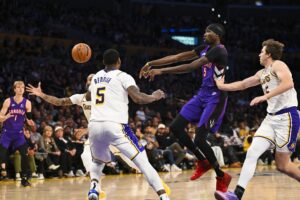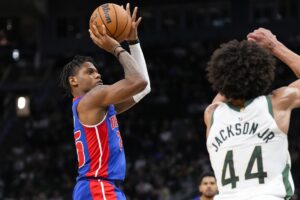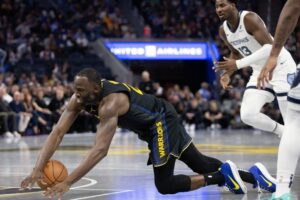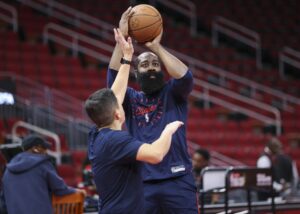During the first 59 games of the 2019-20 season, Denver Nuggets point guard Jamal Murray was one of the most inconsistent players in the NBA, flashing star potential periodically but never being able to put it together. In contrast, during the 2020 playoffs in the bubble, Murray looked like a perennial All-Star, as he upped totals in all categories en route to the conference finals. However, this season, Murray has seemingly regressed. Where is “Bubble” Murray?
Why has Jamal Murray Disappointed this Season?
Jamal Murray’s Bubble Leap
Most NBA fans are aware of Murray’s inconsistencies. Throughout his first few seasons in the NBA, including the regular season of 2019-20, Murray often disappeared in the clutch. The tools were there, but Murray’s production simply wasn’t.
However, during the bubble, Murray seemingly took the leap from potential prospect to superstar. Consider how improbable Murray’s stats were in the bubble. He played 40 minutes a night, shot 45 percent from three-point range on seven attempts per game, and he averaged 26.5 points, five rebounds, and seven assists. In comparison, he averaged 18.5 points, four rebounds, five assists, and 35 percent from three on 5.5 attempts during the 2019-20 season.
In general, Murray’s entire skillset seemed to completely transform in the bubble. From his crazy reverse layups to his newfound off-the-dribble prowess, Murray commanded a higher level of respect from defenders. He exhibited steadfast poise and a newfound attacking mentality, allowing him to become a lethal scorer in the clutch for the first time in his NBA career. Perhaps his numbers were slightly unsustainable, but Murray entered the 2020-21 season as a fringe Most Valuable Player Award candidate and a probable All-Star.
Fall to Earth for Jamal Murray
Some regression was expected, but Murray has largely reverted back to the player he was pre-bubble. The confidence, the savvy, and the productivity have appeared in flashes, but he lacks his prior level of consistency. Again, he seems to disappear for large parts of games, and his scoring and facilitating have greatly dipped. Superstars, even simply All-Stars, show up every night, and Murray hasn’t shown that he belongs in that tier just yet.
For instance, his scoring has pretty much completely regressed from his performances of last year. In 2019-20, he shot 45.6 percent from the field on 15 attempts per game. In the bubble, he shot 50 percent on 19 attempts per game. Now, he’s shooting 44 percent on 16 attempts per game. As a result, he’s gone from 18.5 points per game in 2019-20, to 27 points per game in the bubble, to 18.6 points per game this year.
Furthermore, he’s regressed as a passer, and his facilitation makes up a smaller part of the Nuggets offense. In 2019-20, Murray had a 25 percent usage rate and 23 percent assist rate. In the bubble, Murray had 27 percent usage and 29.5 percent assist rate. This year, Murray has had 23.3 percent usage and 18.4 percent assist rate. What’s really concerning is that Murray has not only significantly dropped off from his bubble numbers, but his facilitation numbers are lower than last year’s. His increased passivity has certainly played a role in this decrease.
Other Factors
While Murray has disappointed this season, his regression can also be attributed to a number of other factors.
One reason may be the Nuggets’ relatively recent run to the Western Conference Finals. With the historically short offseason, it’s possible that Murray may be fatigued or is intentionally toning down his effort during this regular season. Additionally, he may not be taking the regular season seriously after comprehending the immense ceiling of the Nuggets. We’ve seen this phenomenon play out repeatedly, from the Portland Trail Blazers of 2019-20 to this year’s Miami Heat. Once you’ve experienced the high-stakes of a late-round playoff game, a regular-season game in February suddenly isn’t as compelling.
Another reason for Murray’s decline is the emergence of Nikola Jokic as a bonafide Most Valuable Player Award candidate. Jokic’s usage rate, field goal attempts, and assist rate have all ballooned, thus preventing Murray from excelling.
Furthermore, Murray’s decrease in field goal attempts per game can also be traced to the egalitarian play-style of the Nuggets. Murray has only made 22 percent of the Nuggets field goals, down from 25 percent last year and 30 percent in the bubble. Michael Porter’s sudden rise to stardom in the bubble has made him a bigger priority for the team, and his increased reps have cut into Murray’s scoring workload. The same can be said about Will Barton and Gary Harris, both of which were not available during the bubble as well as for large parts of the 2019-20 season. The more spread-out offense has ultimately reduced the scoring workload of Murray. And, the emergence of Jokic has taken away Murray’s assist numbers. As a result, we’re seeing lower numbers across the board, not just in comparison to the bubble but even to last season.
Expectations for Jamal Murray Moving Forward
Murray has regressed to the same player he was last year, but now with fewer touches. There is virtually no remnant of his bubble performance in his current game, with the exception that he is taking more unassisted attempts per game.
Unless he reverts back to his insane percentages or Jokic gets injured, it’s hard to see Murray reach initial expectations. However, don’t be too surprised to see Murray revert to his bubble productivity. We’ve seen Murray do it once, and it’s possible that the playoffs bring a more locked-in version of himself. Additionally, we’ve seen that NBA team rotations often become much shorter during the playoffs, with a greater reliance on superstars. If Murray consequently gains a larger workload, he could approach his bubble productivity.
Ultimately, it all comes down to Murray’s issues with touches and efficiency. Both are able to be remedied, but they depend not only on Murray but also on the Nuggets’ offense. We’ve seen the Nuggets rise to a different level when “Bubble” Murray emerges. Now, it’s time to see if the proper changes can be made to enable a more consistent version of the sharpshooting, playmaking savant that took over last year’s playoffs.
Main Photo
Embed from Getty Images






